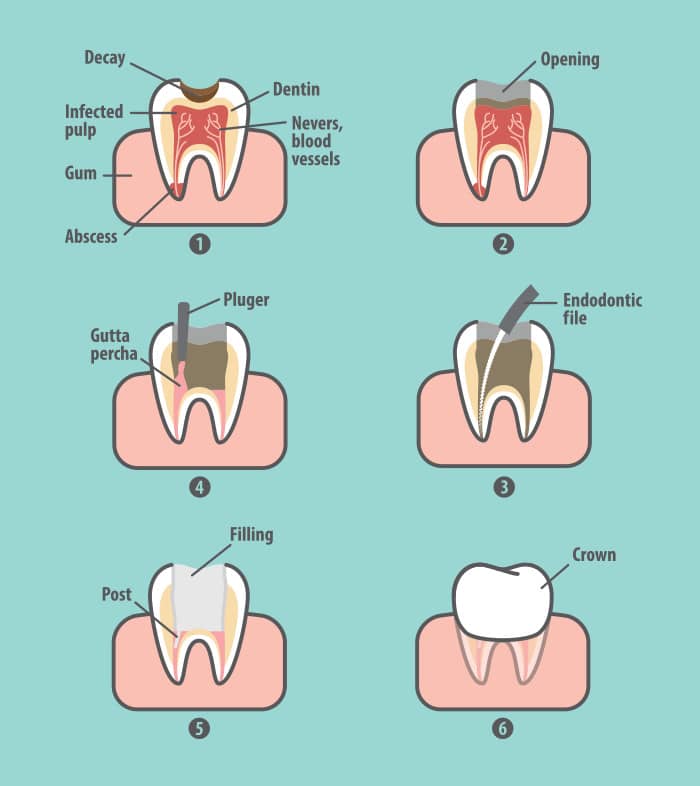Root Canal Treatment
Key Takeaways:
- Leaving your root canal untreated could lead to the formation of an abscess at the tooth’s root. In the worst-case scenario, a delay in treatment makes it impossible for your dentist to save your tooth.
- Root canal therapy also involves filling and sealing the tooth to protect the tooth from dead tissues that have been removed.
- A root canal treatment ensures you have a healthy restored tooth that can last a lifetime

Contents
Several people attach root canal treatment to pain. While this may be true, it is a pain-relieving treatment. The pain stems from the infection, not the treatment. The treatment does not cause pain; rather, it alleviates it.
Root canal treatment is one of the most efficient options for saving your natural tooth. If the treatment can’t save your tooth, the next available option is a dental implant.
The purpose of a root canal is to remove the infected pulp and the bacteria that are causing it, as well as the damaged pulp. It entails removing blood vessels and inflamed or dead nerves from the centre of your tooth.
In this article, we will look at the signs you need to have a root canal treatment, the procedures, and every necessary information you need on the treatment.
What Is A Root Canal?
A root canal is a dental procedure designed to save a tooth that’s severely infected or decayed. The treatment involves removing the infected pulp inside the tooth, cleaning and disinfecting the area, then filling and sealing the tooth’s root canal system to prevent further infection.
When Do You Need A Root Canal?
A root canal is typically needed when there’s an infection deep within your tooth. This can be caused by a variety of factors, including deep decay (from cavities), a chip or crack in the surface of your tooth, or trauma to the tooth that affects the root even if there’s no visible damage. Your dentist will diagnose the need for a root canal based on symptoms and dental imaging.
How Much Does A Root Canal Cost?
The average cost of a root canal without a crown in Australia is between $2,000 and $3,400, according to the 2020 National Dental Fee Survey. In Australia, a three-canal molar root canal can cost as much as $2,760 without a crown and as much as $4,760 with one.
Signs You Need A Root Canal Therapy
In most cases, you may not detect that your teeth are infected. However, there are certain signs and symptoms you need to look out for in terms of your dental health. They include
-
- Swollen gums: Pus can build up around an infected tooth causing the gums to become swollen, puffy, or sensitive as a result.
-
- Persistent tooth pain: Tooth pain is a sign of several dental issues. You could require root canal treatment if you experience discomfort and pain deep inside your tooth. Your jaw or other teeth could experience discomfort as well.
-
- Sensitivity to cold and heat: If you experience pain when taking ice cream or hot coffee, you may need a root canal, especially if it lasts for a long time.
-
- Swollen jaw: When pus is still in the site, it causes swelling of the jaws.
-
- Tooth discolouration: Your teeth will appear darker when the pulp is infected. This is because there isn’t enough supply of blood.
-
- Loose tooth: Pus from the infected pulp can soften the bone around your tooth resulting in a loose tooth.
-
- Pain, when you chew, could signify a damaged or diseased pulp.
Comparison Of Root Canal Treatment Costs To Other Dental Procedures
| Procedure | Cost |
| Root Canal Treatment (front tooth) | $1,000 per tooth |
| Root Canal Treatment (back tooth) | $1,500 per tooth |
| Dental Fillings | $1,500 per tooth |
| Dental Crown | $1,500 per tooth |
| Dental Implant | $3,999 per tooth |

What Are The Treatment Options For Root Canals?
There are other treatment options for root canal treatment which include:
Traditional Root Canal Treatment
In a traditional root canal, a little hole is drilled into the tooth to be treated. After removing the infected or damaged pulp and cleaning and disinfecting the tooth’s root, the little hole is then sealed shut with a rubber-like substance.
Laser Root Canal Treatment
A laser root canal treatment is the same as a traditional one. The only difference is the use of a laser rather than a drill.
Laser root canal treatment leaves the teeth cleaner because it can “boil away” the diseased tissue with far higher accuracy and speed. Laser treatment also ensures there is less bleeding, pain, and discomfort.
Non-surgical Root Canal Treatment
In a non-surgical root canal treatment, the old root canal filling material is removed after accessing the root canals from the top of the tooth. After that, the root canals are cleaned and resealed.
A surgical root canal treatment entails immediately accessing the root’s tip and resealing the root from the tooth’s base.
The non-surgical root canal treatment involves a more detailed technique as drilling goes deeper into the tooth’s root.
The endodontist will administer local anesthesia before drilling into the root canal to extract the infected pulp and clean and fill the tooth to stop future infection or damage.
The pulp chamber and canals are cleaned with sodium hypochlorite to kill any remaining microorganisms.
What Is Involved In A Root Canal Procedure?
A root canal procedure takes place between 1 to 3 sessions. Your dentist will:
Clean the Root Canal
Your dentist begins by removing everything inside the canal. While under local anaesthesia, your dentist will create a tiny access hole on your tooth’s surface and then use tiny files to eliminate the diseased and dead pulp tissue.
File the Root Canal
Your dentist proceeds to use tiny files to clean, shape, and disinfect the area.
Add a Filling or Crown
You shouldn’t put pressure on the tooth until the crown or filling is complete. After the filling or dental crown has been placed, the tooth can function normally.
Your treatment will need extra consultations if there are abnormal canals or severe infections.
How Long Does A Root Canal Take?
A root canal procedure can take between 30 minutes to a fewhours, depending on the complexity of the tooth structure and the extent of the infection. In some cases, multiple visits may be required to complete the treatment.
faqs
How Many Years Does A Root Canal Last?
A root canal can last 10 years or in some cases longer.
What Is The Alternative To Root Canal?
The alternative to a root canal is tooth extraction. In a tooth extraction, your dentist replaces the damaged tooth with an implant, bridge or denture.
Do I Need A Crown After A Root Canal?
Your need for a crown is determined by the amount of remaining tooth structure after a root canal.
What Is a Pulp Root Canal?
A pulp root canal involves removing the infected pulp and sealing the tooth to prevent further infection.
What Happens When Tooth Pulp Is Removed?
After removal, the hollow area is disinfected. Then, the tooth is then filled with a rubber-like substance, and the root canals are completely sealed with adhesive cement.
Is A Root Canal Worth It?
Yes, a root canal is worth it. A proper root canal treatment saves a tooth.
How Long Does A Root Canal Take To Heal?
A root canal recovery time lasts less than a week.
Conclusion
A tooth infection that is left untreated is a ticking time bomb. The infection might spread from the tooth’s roots to the body’s weak tissues.
Root canals have a high success rate. When they fail, it is usually due to the presence of bacteria, missed canals, or leftover tissue. To prevent root canal failure, contact us to book an appointment.




















